
The Duolingo English Test (DET) is a popular alternative to other English proficiency exams such as the TOEFL and IELTS.
But there are several key differences between the questions on those two exams and those on the DET.
As a result, students who are thinking about taking the test can improve their chances of scoring well by knowing how to approach every type of DET question.
Start by heading over to this blog if you want a comprehensive overview of both the test and the advantages of using it to prove English proficiency.
Below is a guide to every type of question you can expect to encounter on the exam as of February 2025.
Once you’re ready, you can sign up for a free practice test on the Duolingo English Test homepage.
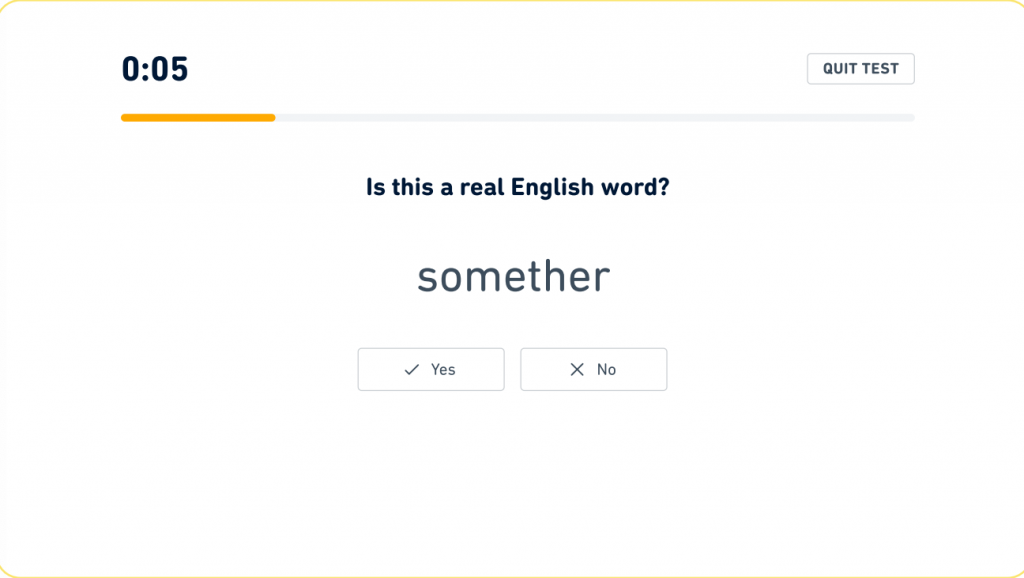
Directions: Identify whether each displayed word is a real English word.
Duration: 5 seconds per word
Individual Subskill Tested: Reading
Integrated Subskills Tested: Literacy, Comprehension
Key Strategies: Read carefully, as some words may look real (they look like they have meaning), but contain small differences. Remember familiar prefixes, suffixes, and valid compound words. Guess if you’re unsure, as incorrect answers on this question type do not receive a greater penalty than skipped questions.
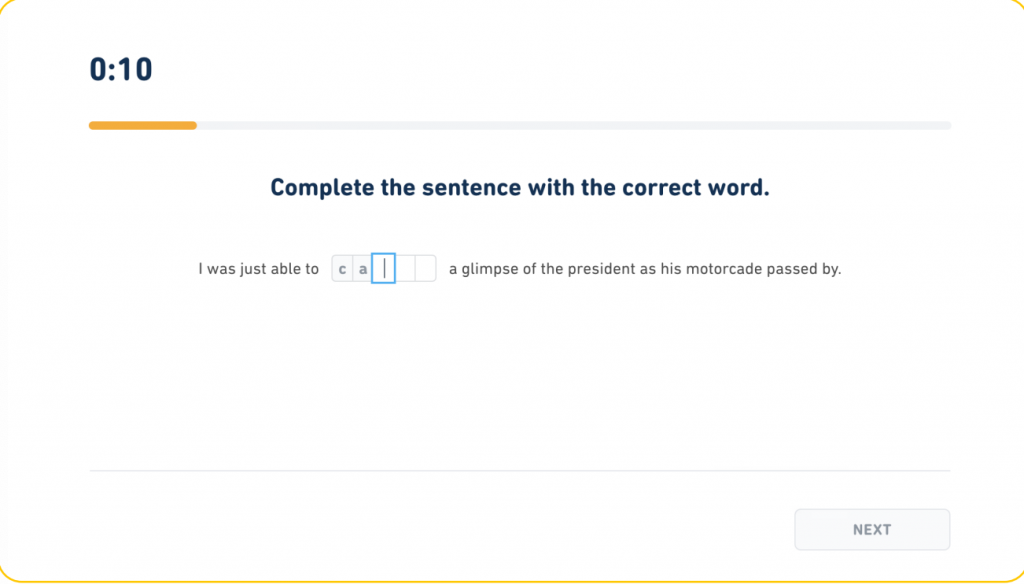
Directions: Complete the given word by filling in missing letters.
Duration: 20 seconds
Individual Subskill Tested: Reading
Integrated Subskills Tested: Literacy, Comprehension
Key Strategies: Use context clues from the sentence to predict the missing letters. Eliminate options by deciding whether the missing word is a noun, verb, adjective, or other part of speech. Keeping in mind popular idioms and collocations (a group of words that are expected to be together) can also help with more difficult questions. Don’t forget to read the entire sentence before answering!

Directions: Fill in the missing letters in a passage.
Duration: 3 minutes
Individual Subskill Tested: Reading
Integrated Subskills Tested: Literacy, Comprehension
Key Strategies: Skim the passage first to get a general idea of the content. Then use context clues to predict missing words. For example, the word success at the beginning of the passage above can help you more confidently guess that the second word to be completed is fail.
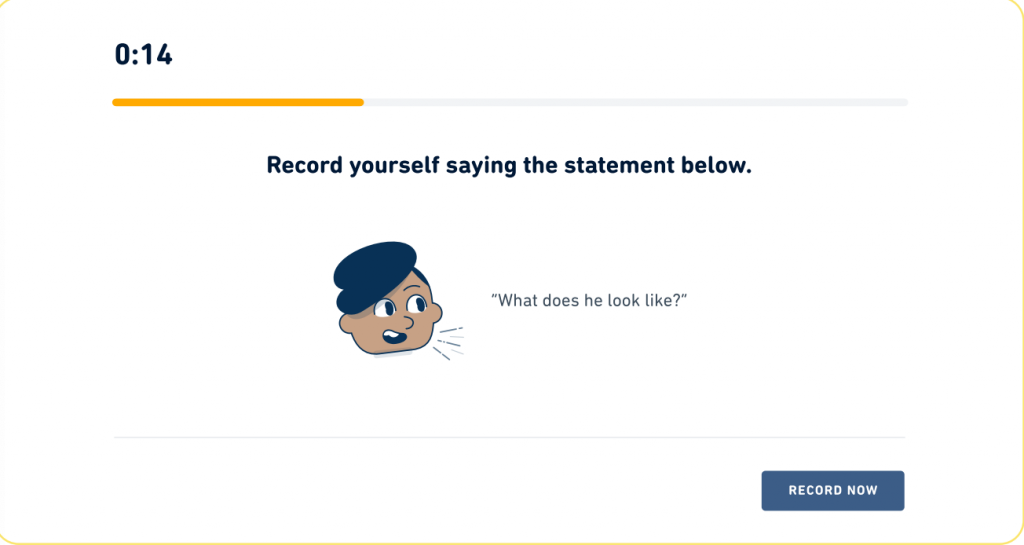
Directions: Read and record the displayed sentence.
Duration: 20 seconds
Individual Subskill Tested: Speaking
Integrated Subskills Tested: Comprehension, Conversation
Key Strategies: Speak clearly and at a natural pace. Pay close attention to punctuation because it is often the key to correct intonation. And if you have enough time, practice once silently before recording.
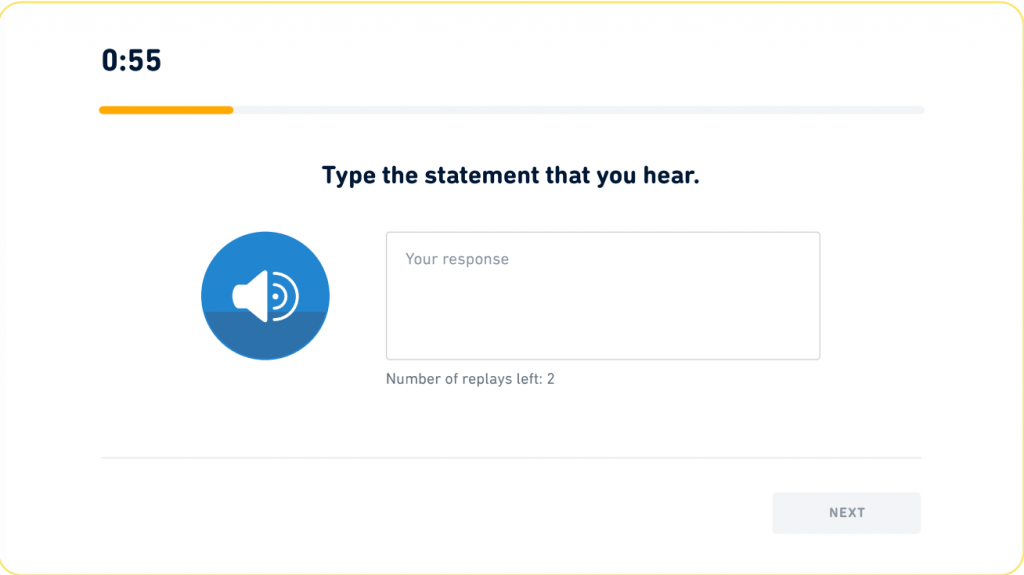
Directions: Listen to a sentence and type it out.
Duration: 1 minute
Individual Subskill Tested: Listening
Integrated Subskills Tested: Comprehension, Conversation
Key Strategies: Listen carefully and don’t be afraid to replay the audio up to three times. Focus on key content words first. Before submitting, check your work one last time to see that you’ve used correct spelling and punctuation.

Directions: Select the best word for each blank in a passage.
Duration: 7-8 minutes (for all questions in section)
Individual Subskill Tested: Reading
Integrated Subskills Tested: Literacy, Comprehension
Key Strategies: Read the entire sentence before choosing an answer. Use transition words and knowledge of correct subject-verb agreement in order to eliminate incorrect answer choices. Don’t forget to re-read each sentence for coherence before moving on.

Directions: Choose the best sentence to fill a blank in a passage.
Duration: 7-8 minutes (for all six questions in section)
Individual Subskill Tested: Reading
Integrated Subskills Tested: Literacy, Comprehension
Key Strategies: Don’t just read the answer choices — read surrounding sentences carefully, too. Identify the logical flow and structure of the passage. Considering pronoun references and transitions are usually crucial.

Directions: Highlight the portion of a passage that answers a given question.
Duration: 7-8 minutes (for all six questions in section)
Individual Subskill Tested: Reading
Integrated Subskills Tested: Literacy, Comprehension
Key Strategies: Skim for keywords from the question. Ensure the highlighted section directly answers the question. Perhaps most importantly, avoid selecting too much or too little text, as either one can cause an answer to be marked incorrect.
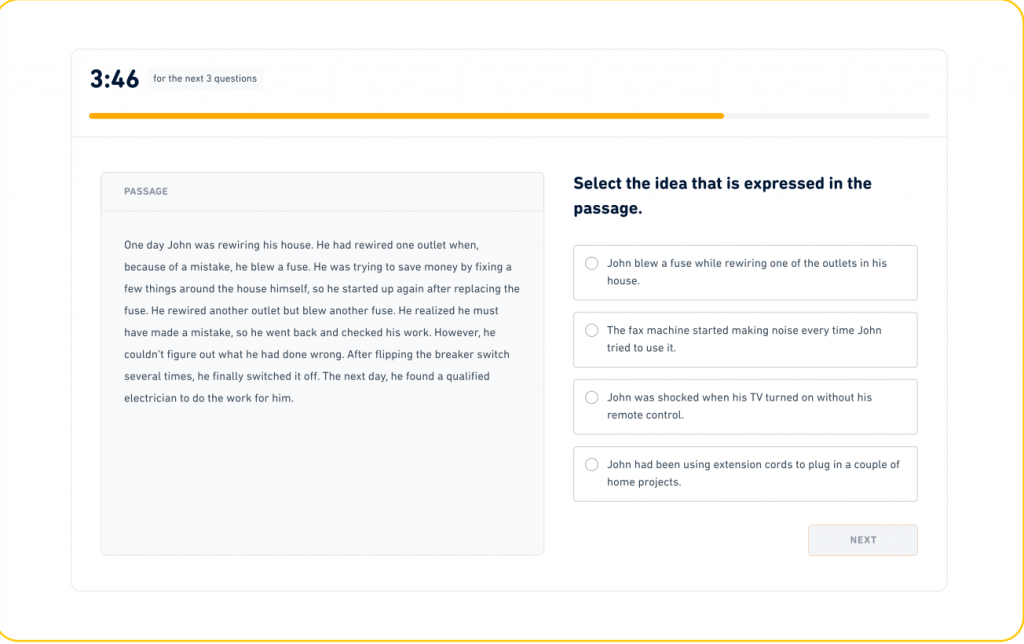
Directions: Select the idea that best represents the passage.
Duration: 7-8 minutes (for all six questions in section)
Individual Subskill Tested: Reading
Integrated Subskills Tested: Literacy, Comprehension
Key Strategies: Do not select answer choices that only include details. Eliminate options that are too narrow or broad. Re-read the topic sentence and concluding sentence of a given paragraph in order to get a better idea of the main topic being discussed.
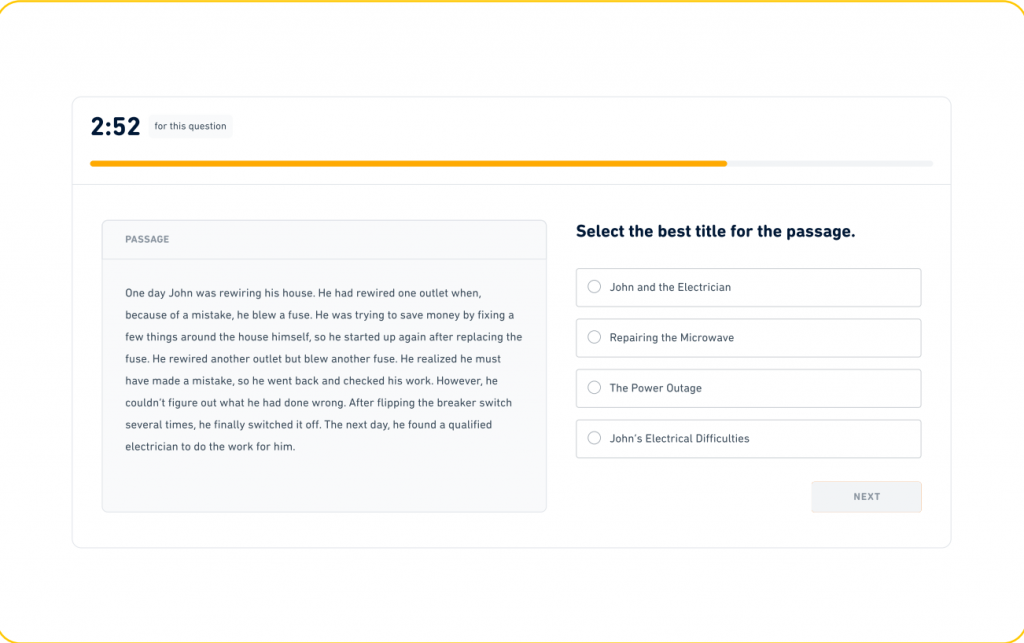
Directions: Choose the best title for a passage.
Duration: 7-8 minutes (for all six questions in section)
Individual Subskill Tested: Reading
Integrated Subskills Tested: Literacy, Comprehension
Key Strategies: Predict the correct answer choice by coming up with your own title for the passage. Your title should reflect the main theme, not just keywords, and avoid overly specific or general titles. Then select the answer that best matches your prediction.
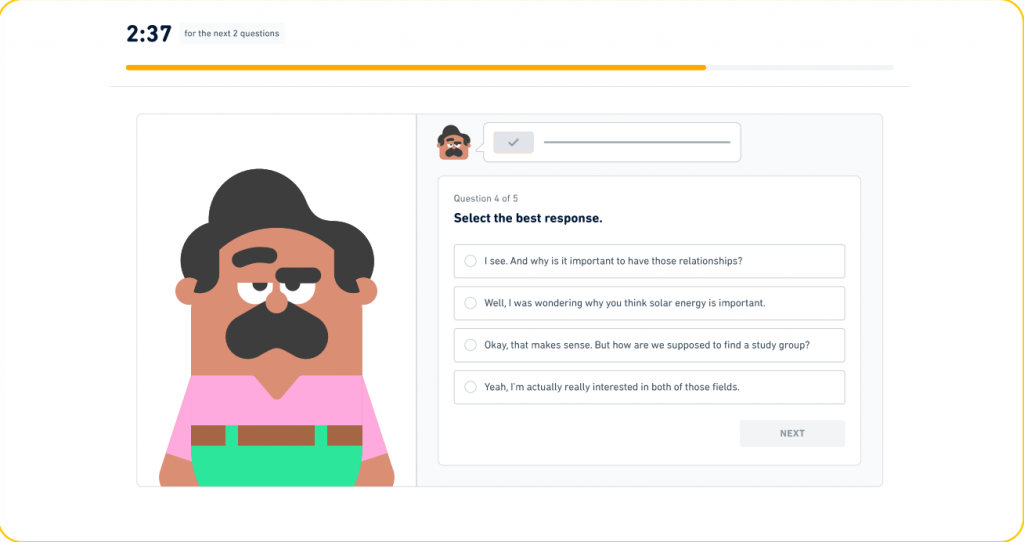
Directions: Listen to an audio prompt and choose the best response.
Duration: 4 minutes
Individual Subskill Tested: Listening
Integrated Subskills Tested: Comprehension, Conversation
Key Strategies: Pay attention to tone and context. Choose responses that logically continue the conversation based on what was said previously. These can be reactions, questions, or a combination of both. Often, incorrect responses will reference things not mentioned in a conversation.
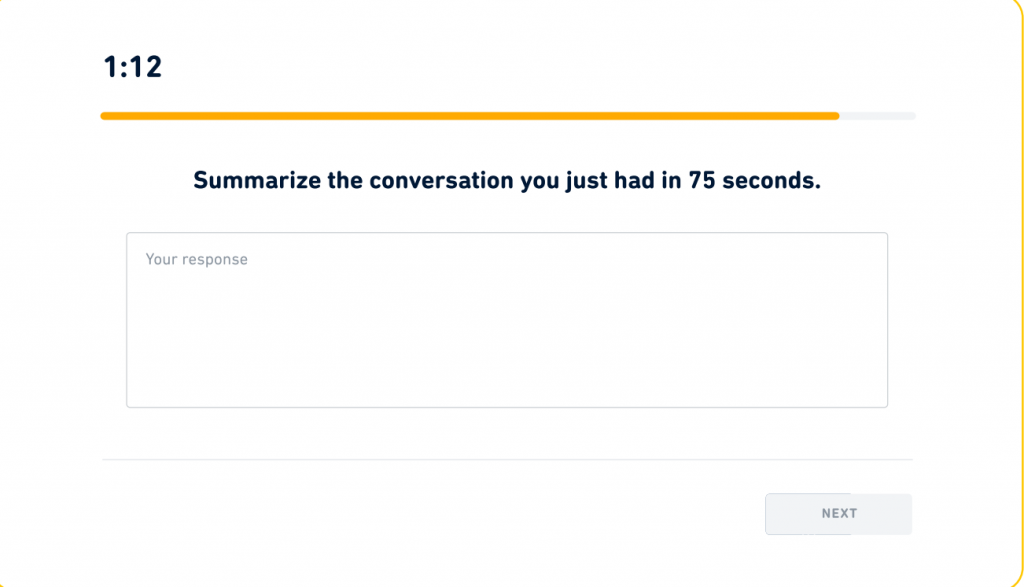
Directions: Summarize the previous conversation in 75 seconds.
Duration: 75 seconds
Individual Subskill Tested: Writing, Listening
Integrated Subskills Tested: Literacy, Comprehension, Conversation, Production
Key Strategies: Remember, this will be the same conversation featured in the Listen and Respond question. Focus on main ideas and on the speakers’ roles. Keep the summary concise but complete. Re-read before submitting to check that you have used clear and correct grammar.

Directions: Describe an image in writing.
Duration: 1 minute
Individual Subskill Tested: Writing
Integrated Subskills Tested: Literacy, Production
Key Strategies: Include details beyond basic descriptions. To do this, first think about the five senses (sight, smell, hearing, taste, and touch). Then brainstorm relevant adjectives or adverbs. Use varied vocabulary and sentence structures to avoid repetition.
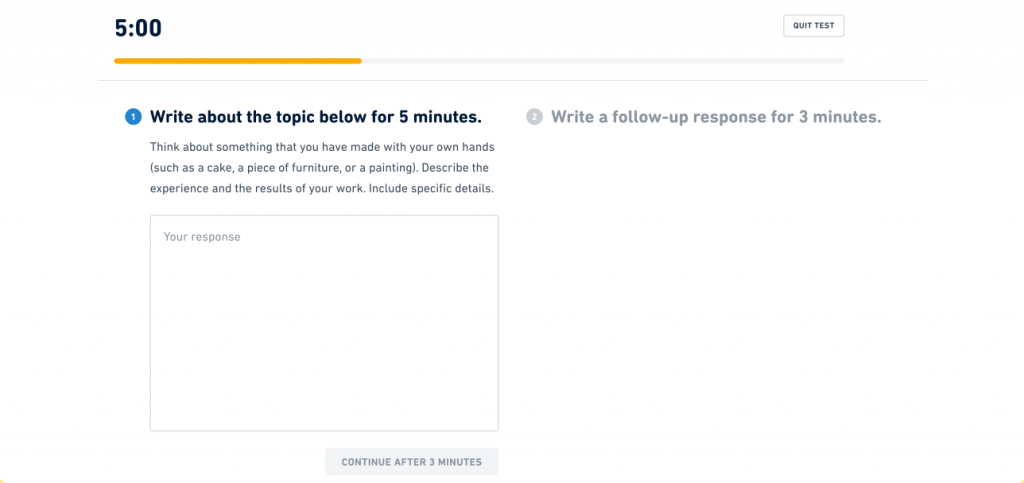
Directions: Write about a topic for 5 minutes, then respond to a follow-up for 3 minutes.
Duration: 5 minutes + 3 minutes
Individual Subskill Tested: Writing
Integrated Subskills Tested: Literacy, Production
Key Strategies: Organize your thoughts before writing. (Don’t worry, though, you’ll be able to see your initial response as you compose the response to the follow-up question, which will usually ask you to provide more detail or to write about a related scenario.) High-graded responses directly answer all instructions in the prompt and keep details to ones that are relevant to the question. That said, don’t try to provide an exhaustive list of details — keep some in mind to include in a follow up.
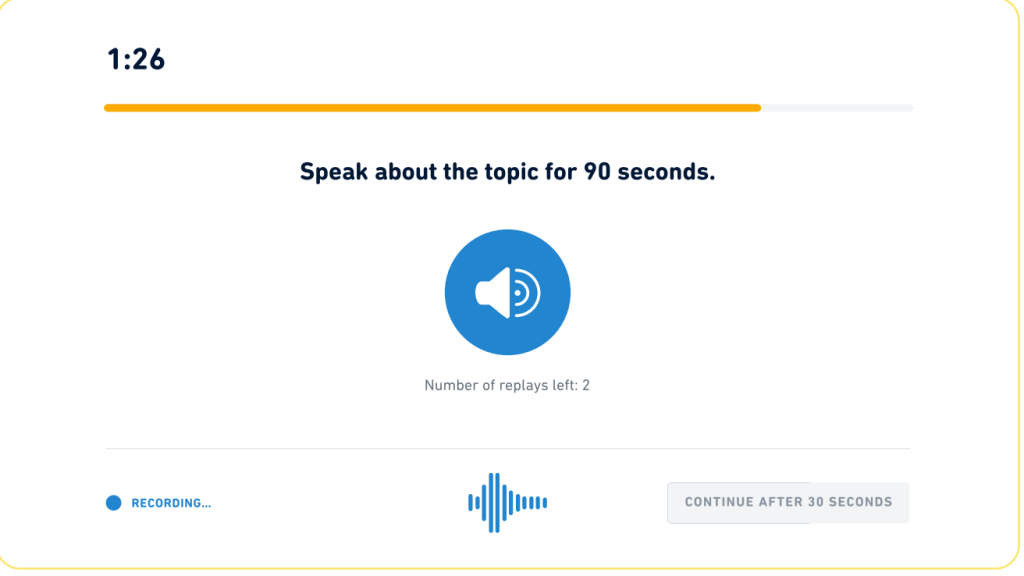
Directions: Listen to a prompt and speak for 90 seconds.
Duration: 30-90 seconds
Individual Subskill Tested: Speaking
Integrated Subskills Tested: Conversation, Production
Key Strategies: Listen carefully before responding. When practicing, focus on fluency before focusing on accuracy. Avoid repeating points by building a mental outline that includes varied details and specific examples.
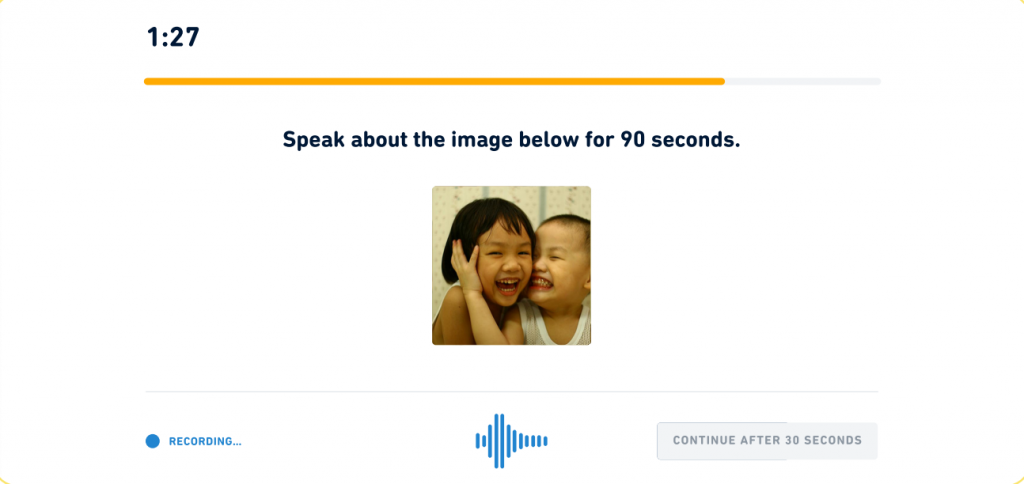
Directions: Describe an image in speech.
Duration: 30-90 seconds
Individual Subskill Tested: Speaking
Integrated Subskills Tested: Production, Conversation
Key Strategies: Cover details beyond simple labeling. Speak naturally and enunciate clearly. Keep a steady pace. It’s okay to include guesses about what might be happening — be creative!
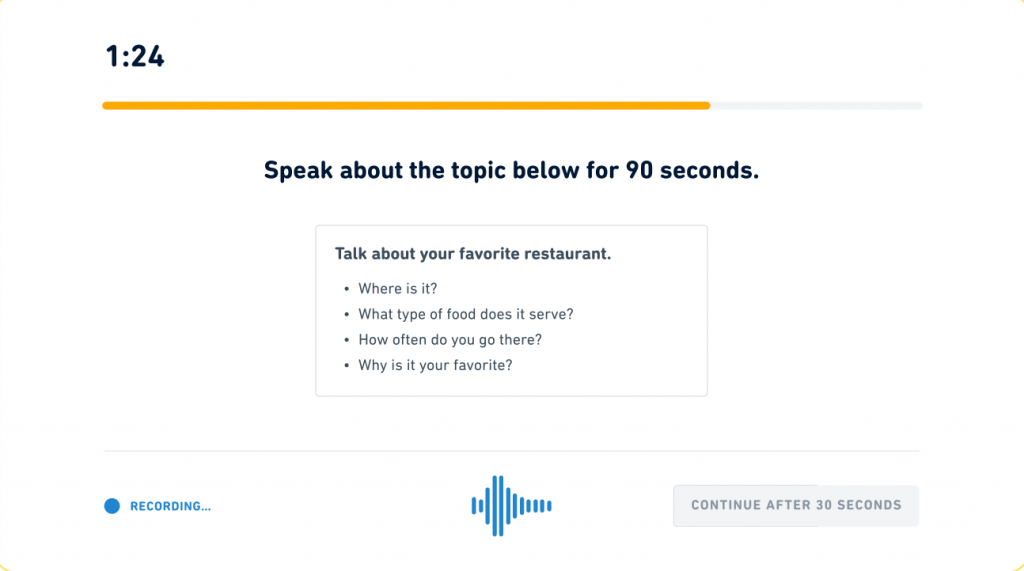
Directions: Read a prompt and speak about it.
Duration: 30-90 seconds
Individual Subskill Tested: Speaking
Integrated Subskills Tested: Conversation, Production
Key Strategies: Structure your response logically according to the questions asked. Expand with details and specific examples. Failing to expand an answer (even to a simple question) is likely to result in a lower score. For example, when responding to the question “Where is it?” in the example above, you could describe the restaurant’s location in relation to your home, to other parts of the city or town you live in, or what else is nearby.
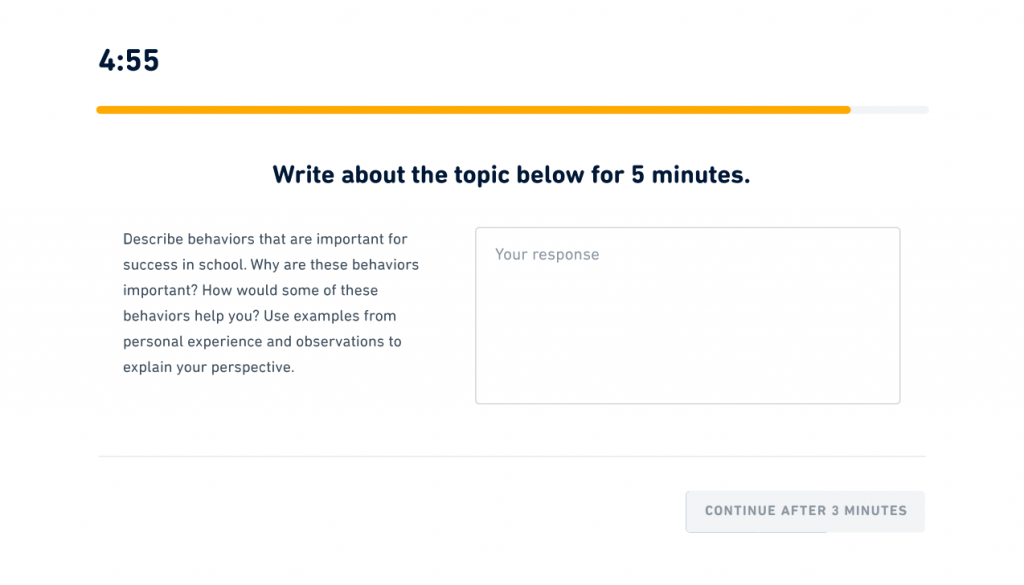
Directions: Write about a topic for 3-5 minutes.
Duration: 3-5 minutes
Individual Subskill Tested: Writing
Integrated Subskills Tested: Literacy, Production
Key Strategies: Treat this task as a short essay. This means including a main argument that directly answers all parts of the prompt, plus two or three pieces of evidence (from your own experience or prior knowledge) and one example or detail for each. Proofread if time allows.
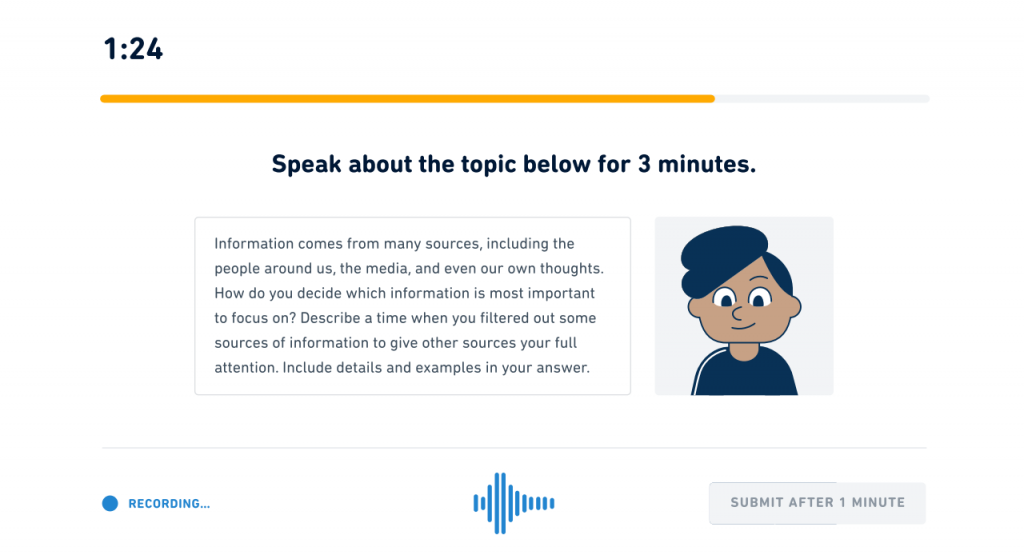
Directions: Speak about a topic for 1-3 minutes.
Duration: 1-3 minutes
Individual Subskill Tested: Speaking
Integrated Subskills Tested: Conversation, Production
Key Strategies: Speak naturally and confidently. Use expressive language, but don’t forget to structure your response so that it directly answers the prompt. It’s okay to use language from the prompt to begin parts of your response. When giving examples or details, it may help to pretend you are explaining something to a friend or family member.
Doing well on the Duolingo English Test starts with knowing the different question types and how to approach them.
Though we’ve covered each one here and given you tips to improve your score, the key to success is practice. If you’re planning to take test in the near future, get comfortable with the test format, focusing on accuracy first, then trying to improve timing later if needed.
Plus, the more you practice, the more confident you’ll feel on test day, giving you the best chance of earning a score that you can be proud to send to schools abroad.
For international school students, it’s important to know that no matter where you are on your academic journey, there is a strategic course of action available to help you achieve your admissions goals. Tokyo Academics has over 10 years of experience helping students get the grades, test scores, essays, and other factors needed to gain admission to top schools around the world. Connect with us today to see how we can help you get into the boarding schools and colleges of your dreams!
Visit our Resource Center and gain access to recorded webinars, podcast episodes, school profiles, and more.